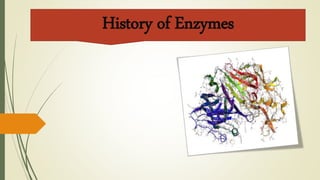
History of enzymes.
- 2. Synopsis Introduction to origin of Enzymes What are Enzymes? Enzymes are divided into six major classes Kirchoff's Observation Discovery of First Enzyme Louis Pasteur Conclusion Buchner's Contribution Sumner's Postulation Enzymes and X-ray Crystallography Discovery of Ribozyme and Restriction Enzymes
- 3. Introduction to the origin of Enzymes The earliest known references to enzymes are from ancient texts dealing with the manufacture of cheeses, breads, and alcoholic beverages, and for the tenderizing of meats. These processes were known as fermentation. Kühne, studying catalysis in yeast extracts, first coined the term ‘‘enzyme’’ (1877). The word derives from the medieval Greek word enzymos, which relates to the process of leavening bread. Today enzymes continue to play key roles in many food and beverage manufacturing processes and are ingredients in numerous consumer products, such as laundry detergents (which dissolve protein-based stains with the help of proteolytic enzymes). Enzymes are also of fundamental interest in the health sciences, since many disease processes can be linked to the aberrant activities of one or a few enzymes.
- 4. What are Enzymes? Enzymes Biological Catalysts Presents in all living Cells Made of Protein Converts substrates into products Remain unchanged by chemical reaction Increase the rate of chemical reaction
- 5. Enzymes are divided into six major classes Oxidoreductases catalyse oxidation - reduction reactions. Transferases catalyse transfer of functional groups from one molecule to another. Hydrolases catalyse hydrolytic cleavage. Lyases catalyse removal of a group from or addition of a group to a double bond, or other cleavages involving electron rearrangement. Isomerases catalyse intramolecular rearrangement. Ligases catalyse reactions in which two molecules are joined.
- 6. Kirchoff’s Observation 1812, The Russian chemist Kirchoff was studying the following conversion i.e- starch sugar. When a suspension of starch was boiled, Kirchoff observed, no change occurred in the starch. When he added a few drops of concentrated acid before boiling the suspension, the starch broke down to form glucose. The acid which clearly facilitated the reaction underwent no change. 1835, the Swedish Chemist Jons Berzelius provided a name to the process Kirchoff had observed, “Catalysis”. in the presence of strong acids
- 7. Louis Pasteur Conclusion In 1850, Sugar Alcohol ( Fermentation) Louis Pasteur concluded that it is catalysed by “ferments” and these ferments were inseparable from the structure off living yeast cell, this view, called vitalism prevailed for decades. He wrote that:- Alcoholic fermentation is an act correlated with the life and organisation of yeast, cells, not with the death and putrefaction of the cells. Yeast
- 8. DISCOVERY OF FIRST ENZYMES By the late 17th and early 18th centuries:- Digestion of meat by stomach secretions Starch Sugar (By plant extracts and saliva) French chemist Anselme Payen was the first to discover an enzymes, diastase, in 1833. It was extracted from malt solution.
- 9. Buchner's Contribution Eduard Buchner submitted his first paper on the study of yeast extracts in 1897. 1 1897: Eduard Buchner using the ‘‘pressed juice” from rehydrated dried yeast demonstrated that alcoholic fermentation could be performed in the absence of living yeast cells. 2 He named the enzymes that brought about the fermentation of sucrose “ Zymase”. 3 In 1907, he received Nobel Prize in Chemistry for his “Discovery of Cell- Free Fermentation”. 4
- 10. Sumner's Postulation In 1926, James B. Sumner showed that the enzymes urease are use was a pure protein and crystallized it from jackbean. His work made him earn Noble Prize in 1947. Sumner found that urease crystals consisted entirely of protein and he postulated that all enzymes are protein. The conclusion that pure protein can be enzymes was definitively demonstrated by John Howard Northrop and Wandell Meredith Stanley.
- 11. Enzymes and X- ray Crystallography The discovery that enzyme could be crystallised eventually allowed their structures to be solved by X- RAY crystallography. This was first done for Lysozyme, an enzymes found in tears, saliva and egg whites that digests the coating of some bacteria. The structures was solved by a group led by David Chilton Phillips and published in 1965.
- 12. Discovery of Ribozyme and Restriction Enzymes In the early 1980s, research groups led by Sidney Altman and Thomas Cech independently found that RNAs can also act as catalysts for chemical reactions. This class of catalytic RNAs are known as Ribozymes and the finding earned Altman and Cech the 1989 Nobel Prize in Chemistry. By the late 1960s, and early 1970s, Restriction enzymes were discovered and characterized by molecular biologists were Aeber, Hamitton Q . Smith and Daniel Nathane.
- 13. “I think that enzymes are molecules that are complementary in structure to the activated complexes of the reactions that they catalyse, that is, to the molecular configuration that is intermediate between the reacting substances and the products of reaction for these catalysed processes. The attraction of the enzyme molecule for the activated complex would thus lead to a decrease in its energy and hence to a decrease in the energy of activation of the reaction and to an increase in the rate of reaction.” - Linus Pauling Nature 161(1948):707
